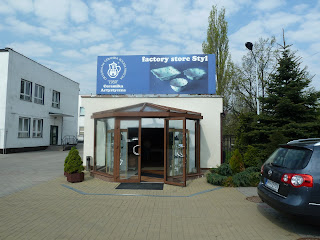The photos of the camp don't even come close to the feeling and emotion you experience as one sees it in person. We have taken just a sampling of pictures of what took place. You will notice the artifacts from the prisioners, the uniforms of the guards, the tubs where the clothes were decontaminated, the showers and then the gas chambers. From here they were hauled to the crematoriam, which if you were walking/driving by on the street, 500 yards from the site you could see the smoke of the burned bodies. This camp was in sight of homes, streets and even a Catholic cemetary, but no one seemed to notice or care. The monument in front is a dedication for the memory of all who were taken at this horrible place. If you look closely, or enlarge it you see it's size when you notice Jean at the base on the left.
Afterwards, we visited the old town, (Renyk) for a look at some of the old, restored buildings and shops. There must have been 85 places to eat so of course we had to find a nice little Jewish food cafe where we indulged in Humas with olives and the freshest pita bread ever put in one's mouth along with a wonderful feta-layden Greek salad with a sweet olive oil dressing. I couldn't get enough!
There are a few photos of the castle which remains after years of turmoil. During WW II the Germans used it as a place to house Polish political prisioners, who after the Germans were forced into retreat by the oncoming Russians killed many thousands as they abandoned the castle grounds.
A final note; the young lady in the photo had just walked out from under the archway and then stopped, looking around as if she was posing for a photo. So of course, I obliged her and was especially interested in how anyone could manuever around on cobblestone streets in what looked to be 6-7" highheels. This, of course, was my one and only reason for snapping this picture..................??





















































